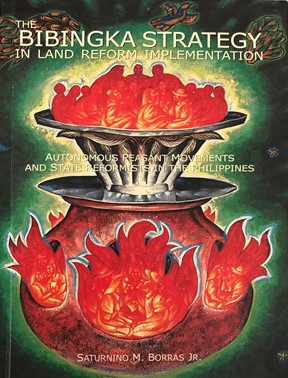Bibingka Strategy: A Conceptual Summary
The ‘bibingka strategy’ is a popular framework used by civil society groups in the Philippines in pursuing reforms and promoting accountability. It comes from the word bibingka — a type of Filipino rice cake that is cooked by placing live charcoal simultaneously on top of and below the dough during the baking process. This strategy proposes that reforms are likely to occur if: (1) there is sustained citizens’ pressure from below, and (2) enabling actions are taken by state reformers from above. Pressure from below is generated by civil society organizations (CSOs) clamoring for substantive policy changes or better policy implementation. Action from above, on the other hand, comes from state officials who seek to enhance service delivery or curb government inefficiency.
With sufficient demand from below and with adequate opening from above, state and societal actors are able to interact with one another, which then pushes the reform agenda forward. Coined by scholar-activist Saturnino Borras, Jr., the term ‘bibingka strategy’ refers to the mutually reinforcing reform measures undertaken by government leaders from above and the radical actions by autonomous peasant movements from below.
First used in the study of agrarian reform implementation in the Philippines, this framework suggests that “the symbiotic interaction between autonomous societal groups from below and strategically placed state reformists from above provides the most promising strategy to offset strong landlord resistance to land reform” (Borras 1998: 125). It further points out that the successful implementation of land reform involves the “symbiotic interaction between autonomous societal groups from below and state reformists from above” (ibid.: 134). As Borras explains in his pioneering book The Bibingka Strategy in Land Reform Implementation:

The outcomes of the land reform policy are not determined by either structural or institutional factors alone, or by the actions of state elites alone, but the political actions and strategies of a wide range of state and societal actors also bear on the outcomes of the reform process (ibid.: 125).
However, this does not mean that the interests and objectives of the various actors from “above” and “below” are completely complementary. Instead, the strategy assumes that there are potential and actual differences between and among state reformists and autonomous rural movements. By focusing on both government action from “above” and peasant mobilization from “below,” the ‘bibingka strategy’ refutes the assumption that the rural poor are either passive recipients of change or mere tools of revolutionary forces that reject policy reforms. The approach instead recognizes peasants as autonomous political actors, capable of mobilizing around specific land rights claims while contributing to the overall process of democratization. The approach further maintains that actual reform work occurs at various levels of engagement, with numerous pro-reform actors interacting at each of these levels. As Borras argues:
The alliance between state reformists and autonomous reformist societal groups can, under certain conditions, surmount obstacles, overcome limits, and harness opportunities to allow a redistributive land reform to occur. This alliance is achieved at various levels of the polity, but in a highly varied and uneven manner, geographically, across crops and farm types, across land reform policy components, and over time (2007:11-12).
The ‘bibingka strategy’ draws from Jonathan Fox’s concept of sandwich strategy, which combines pressure from above and below to counteract anti-accountability forces. It is obviously not a direct translation, but using the term ‘bibingka strategy’ has the advantage of enabling ordinary Filipinos to immediately grasp the meaning of the concept. While sandwich coalition can be easily understood, the phrase sounds too foreign and distant for local ears. But the response is almost automatic when Filipinos hear the term ‘bibingka strategy’, creating a mental image of ‘apoy sa taas at apoy sa baba’ (fire on top and fire below).
Fox first used the term sandwich strategy in his study of the Peasant Store Program—a nationwide initiative of Mexico’s federal government that began in 1980 “to confront the twin crises of low production and widespread hunger” (1992: 1). Meant to provide subsidized basic food products to thousands of low-income villages, the program entailed the creation of community-managed stores that would deliver subsidized grain to the rural poor. To do so, the national government deployed hundreds of community organizers to rural villages to organize village-store management committees. These were then federated into Community Food Councils, which were tasked with overseeing food distribution efforts at the regional level.
Both the committees and Community Food Councils held regular assemblies attended by ejido (village) residents. At first, these meetings were solely focused on topics concerning the program. But by bringing the whole communities together, these assemblies soon became venues for villagers to discuss a whole range of issues, enabling villagers to raise their “voice” and freely criticize certain government officials. These rural formations eventually evolved as alternative sources of power, as traders and local elites tried to gain control of the program. Fox observed that “once the state created an institutional ‘access route,’ organized peasants not only occupied the space but tried to broaden it as well” (ibid.: 203).
With state reformists strategically placed in important positions in the bureaucracy and with active peasant movements at the grassroots level, Mexico’s Peasant Store Program succeeded in delivering subsidized grain while insulating the said initiative from entrenched interests. Learning from this experience, Fox concludes that sandwich strategy occurs when there is “the mutually reinforcing pressure from above and below” (1992: 208). This involves the “objective alliance between entrepreneurial reformists and autonomous social movements (which) can offset the power of entrenched authoritarian elites and may well account for rural reform dynamics across a wide range of political systems” (ibid.: 8).
The ‘bibingka strategy’ became so influential that the term was eventually used both as an analytical approach and as a framework for action. Practitioners view the ‘bibingka strategy’ as a useful framework for wresting power from the landed elites in favor of the rural poor. Academics, on the other hand, see it as an analytical approach to explain the relationship and dynamics of various reform actors from both civil society and the state (Isaac et al. 2017).
‘Bibingka strategy’ became so mainstreamed that it was even considered as the reform strategy of the administration of former President Fidel Ramos.
However, its success also has its baggage. As it became mainstreamed, its use was watered down. By 2000, collaborative government-CSO engagements were being dubbed as an application of the bibingka strategy. One such approach is called ‘constructive engagement,’ which is defined as “building of a mature relationship between two naturally opposable parties—i.e., citizens or citizen groups, on the one hand, and government—bound together by a common reality” (Affiliated Network for Social Accountability in East Asia and the Pacific). Its proponents argued that constructive engagement possessed elements of the bibingka strategy since it emphasized state reformers and civil society working towards the same goals. However, the emphasis on autonomous mass organizing, pressure politics and protest was dropped and most of the engagement centered on or is anchored to government agenda, rather than citizen interest and issues. This arguably limits what the strategy could achieve as it is only fitting for agendas that are non-threatening and pacifying leaving behind contentious reforms that require radical changes.
References
Affiliated Network for Social Accountability in East Asia and the Pacific (n.d.). “Mission.” Retrieved from: http://www.ansa-eap.net/about-us/who-we-are/mission/.
Borras, Saturnino Jr. 1999. The Bibingka Strategy in Land Reform Implementation: Autonomous Peasant Movements and State Reformists in the Philippines. Quezon City: Institute for Popular Democracy.
Borras, Saturnino Jr. 2007. Pro-Poor Land Reform: A Critique. Ottawa: The University of Ottawa Press.
Borras, Saturnino Jr. and Jennifer Franco. 2008. “Reforming Land Reform in the Philippines.” IDS Research Summary. Brighton: Institute of Development Studies.
Borras, Saturnino Jr. and Jennifer Franco. 2010. “Redistributing Land in the Philippines: Social Movements and State Reformers,” in Citizen Action and National Policy Reform: Making Change Happen. John Gaventa and Rosemary McGee (eds.). London and New York: Zed Books.
Fox, Jonathan.1992. The Politics of Food in Mexico: State Power and Social Mobilization. Ithaca and London: Cornell University Press.
Fox, Jonathan. 2018. “Doing Accountability Differently: Vertically Integrated Civil Society Policy Monitoring and Advocacy,” in Going Vertical: Citizen-Led Reform Campaigns in the Philippines (Second Edition). Joy Aceron (ed.). Quezon City and Washington DC: Government Watch and Accountability Research Center.
Isaac, Francis, Danilo Carranza and Joy Aceron. 2017. “From the Ground Up: Multi-Level Accountability Politics in Land Reform in the Philippines.” Accountability Working Paper, 2. Washington D.C.: Accountability Research Center.



